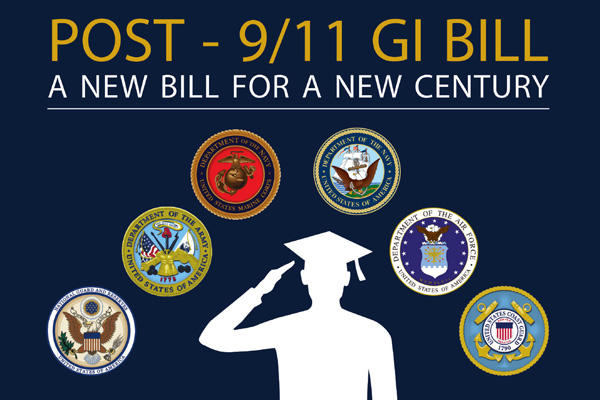The GI Bill was created in response to an outcry of the treatment of World War I veterans, who often returned to the U.S. with little more than enough money to get home. Originally called the "The Servicemen's Readjustment Act of 1944", this bill started out as much more than tuition assistance.The benefits also included help in obtaining mortgages, business loans, and unemployment benefits. The GI Bill was also a driver in sending middle class citizens to college, something previously only available to the wealthy elite. At its peak in the late 1940s, nearly half of the students entering college were veterans!
As the needs of the United States and its service men and women have changed over the years, so too has the GI Bill. First it was revamped in 1984 and titled the "Montgomery GI Bill" and then again in 2008 and titled "The Post-9/11" GI Bill. Now servicemen and women can choose from either of the two to help them obtain an education.
How to Choose Your Benefits
The GI Bill is now solely focused on monetary aid to help cover cover college tuition, housing, books, and other educational fees. This applies to graduate or undergraduate school and the following programs if they have previously been approved: vocational training, on-the-job training, flight training, correspondence training, licensing, national testing programs, entrepreneurship training, and tutorial assistance. You can choose between the Montgomery GI Bill or the Post-9/11 GI Bill, but you must choose carefully as this decision is not reversible. Below is a general breakdown of the modern-day GI Bill, but you can also find answers to your most specific questions here.
1) Montgomery GI Bill
Education benefits through the Montgomery GI Bill are available to those enlisted in the US Armed Forces, including selected reserve. Veterans must have been honorably discharged to qualify. Upon enrolling, you pay $100 for 12 months to receive a monthly education benefit upon completion of the minimum service obligation. You are then eligible for up to 36 months* of benefits. These benefits are paid to the you directly. You have up to 10 years after active duty to receive these benefits.
*When referring to the maximum amount of benefits, 36 months doesn't mean consecutive months - you are only paid GI Bill benefits while you are actually enrolled in classes
See our Montgomery GI Bill page for more details.
2) Post-9/11 GI Bill
Often considered to be the most beneficial solution for veterans, the Post-9/11 GI Bill is available to those who were active duty service members with at least 90 days of aggregate service after September 11, 2001. Veterans must have been honorably discharged to qualify. If discharged due to a service-connected disability, you’re eligible if you served for at least 30 days at the time of discharge. Like the Montgomery GI Bill, this bill provides up to 36 months of benefits but unlike the Montgomery GI Bill, tuition and fees are paid to the school directly, with only the monthly housing allowance and books and supply money going to the student. If you left the service before Jan. 1, 2013 you have up to 15 years after active duty to receive these benefits, if you left the service after that date your benefits never expire.
With both of these programs, you are able stop and start using the benefits as needed.
See our Post-9/11 GI Bill Overview page for more details.
Bonus: Yellow-Ribbon Program
If you are attending a private school, your costs may be more than the VA will reimburse. To rectify this, there is something called the "Yellow Ribbon Program" This is aid offered by an individual school to ensure that the veteran’s costs are covered if the GI Bill doesn't cover them all. However, there is no guarantee for receiving tuition assistance through this program - you have to choose a school that offers it (and therefore has a partnership with the VA) and then that school gives the aid out on a first come, first serve basis. See our Yellow Ribbon Program page for more details.
Keep Track of Your Benefits - or You Could End Up Owing the VA Money
The GI Bill is a benefit to you and should never cause you harm. However, there is the possibility that this could cause you to incur student debt. That's why it's imperative that you keep track of your benefits each and every semester (or quarter, depending on where you go to school). Debt can take many years to pay off and can set you back not just financially, but in your future goals - so don't let this happen to you!
How could this happen? If, for example, your school was overpaid on tuition, the VA has the right to obtain that money back from you. The best way to make sure this doesn't happen is to visit your school’s financial aid office each semester or quarter to check the cost of tuition and fees and compare that to the amount that was awarded to your school. If there is a discrepancy and the possibility that you owe a debt, you can begin rectifying this by contacting The VA's Debt Management Center at 800-827-0648 or dmc.ops@va.gov. Do not let this situation grow to a point at which you cannot rectify it. Stay on top of your aid each and every time you begin classes and you should never have to worry about this.
Keep Up With Your Education Benefits
Whether you need a guide on how to use your GI Bill, want to take advantage of tuition assistance and scholarships, or get the lowdown on education benefits available for your family, Military.com can help. Sign up for a free Military.com membership to have education tips and benefits updates delivered directly to your inbox.




